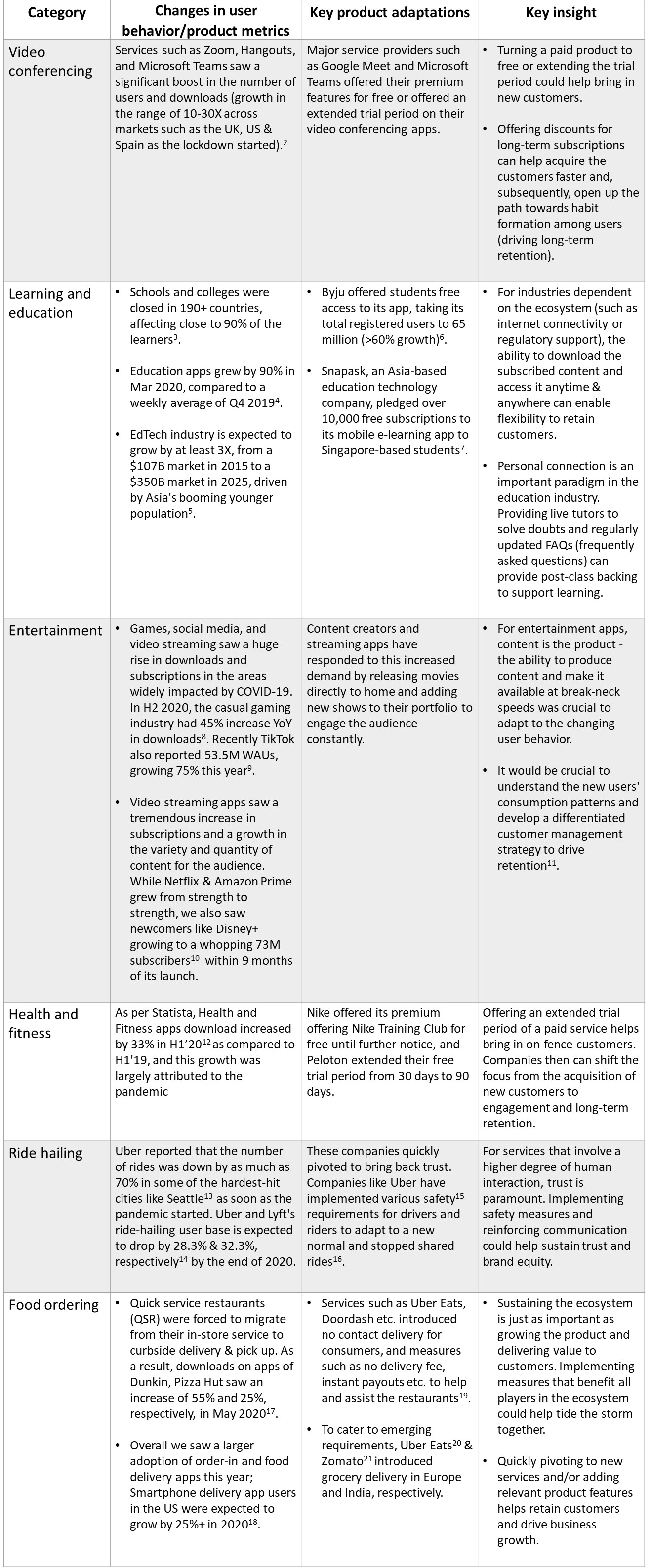The pandemic and the response to it by people & administration has altered the world around us in many ways. Amidst the changing environment, people have also adapted to the new normal by adopting several new behaviors in their daily lives – be it integrating working from their homes or changing purchasing and entertainment patterns.
Key trends of 2020 & what we could learn from them:
Today, we are spending more time online and on our mobile phones1 – consuming new content, engaging in games, or using our phones to take time off and help focus. Apps in certain categories (e.g. video conferencing, learning, social media, gaming etc.) saw a huge boost in downloads & usage whereas apps in some other categories saw major drop in use (e.g. travel, ride-hailing services).
While these changes were driven by underlying shifts in user behavior, we saw some interesting tactics deployed by product, growth and marketing teams around the world to adapt to these changes and drive better outcomes for their products. Let’s take a look at some of these interesting tactics, which could potentially be adopted by many more products going forward:
The way forward – Sustaining product growth or bouncing back post-pandemic
2021 presents hope for everyone – with vaccines & normalcy around the corner, beneficiaries from the newer trends wish to sustain this momentum (and the new user behavior). Products that had to slow down this year are hoping to pick up steam once again next year. Here are some of the key challenges awaiting product, marketing, and growth executives as they plan forward:
- Translate short term growth to long term gains
Today, most product managers of successful products would be keen to capitalize on the recent user behavior and translate short-term gains (in scaled acquisitions) to long-term gains (in the form of a strong, active user base). The growth spurt we’ve experienced recently has not only retained core users but also attracted “on the fence” users or users with no prior use case. For example, several executives across the globe have turned into “power” users of video conferencing apps such as Zoom, Microsoft Teams, etc., as meetings became virtual (and WFH seems to be here to stay). While it’s natural to wish to retain everyone, it’s not feasible, and executives would have to identify users that should be retained and create relevant engagement hooks and develop appropriate user habits for these customers to sustain product usage:
Go beyond the topline metrics – Product, marketing, and growth managers should go beyond the usual funnel metrics and better understand ongoing product/ feature usage. While topline metrics (funnel metrics) help understand the quality of acquisitions and initial user behavior on the product, they are fairly limited in tracking ongoing product/feature usage. They do not help build a deeper understanding of the users & their interactions with the product.
Define metrics to build/ track habits – Product managers should also define metrics that follow the user’s journey with the product to track this information and identify actionable insights to build relevant habits for different user segments.
- Understand and adapt to rapid changes in user behavior
The behavioral changes on the app typically reflect its users’ lifestyle changes. Post the initial disruption at the beginning of the pandemic, we saw users adapting to the new normal. However, this new normal is not constant and shall continue to evolve post-pandemic. As users adopted technology trends at a fast pace, it is equally likely that some of these trends would reverse even faster as normalcy resumes. Executives should closely watch, understand and react to the user behavior around their use-cases:
Understand the “why” behind the metrics – While data can inform “what” is happening in the product, talking to the users will help understand “why” it is happening and explain mental models that power user behavior. This can help product managers “design” relevant product features and/or user journeys to adapt their offerings to ‘user’s needs and motivation as well as help marketing & growth teams understand different user segments, their context and engage them better.
Evaluate & evolve product-market fit – While fast-changing user behavior is challenging to operate in, ‘it’s also an opportunity for companies to experiment & innovate faster. As we’ve seen in the case of Uber Eats and Zomato (mentioned above), products have successfully added use cases to adapt to the changing user habits and continue to be relevant. Product managers should focus on extracting insights around needs and motivations outside their existing use-case to identify opportunities to scale (or pivot) their product and continue to be relevant to more users.
- Be ready to react quickly
Companies that can closely follow, understand, and adapt to evolving market conditions & user behaviors would be better placed to navigate uncertainty better. The post-pandemic stage is likely to move at a fast pace as well, and it would be imperative for executives to stay on top of the latest & greatest product performance and the user behavior around their use-cases and react quickly:
Review & reorient “growth plans” regularly – Set up a “rapid response team” or a “war room,” composed of cross-functional team members, responsible for reviewing the health of the business (weekly/fortnightly) and respond quickly to the changes in product usage patterns. This team could also review & revise product growth objectives and set clear short/long term goals for the rest of the teams in the organization.
Invest in the right infrastructure – The success of data-driven decision making depends on the quality & quantity of the data and the ability to mine actionable insights out of it efficiently. As the demand for data-driven insights around user behavior increases exponentially with higher product adoption, the system could be limited by its ability to handle the increased workload, thereby affecting the execution speed. Evaluate efficiency & scalability of your data infrastructure regularly to set up a robust support system to understand your users better and react quickly to any emerging trends.
References:
- 1https://www.appannie.com/en/insights/market-data/coronavirus-impact-mobile-economy/
- 2https://www.appannie.com/en/insights/market-data/video-conferencing-apps-surge-coronavirus/
- 3https://www.cnbc.com/2020/06/08/edtech-how-schools-education-industry-is-changing-under-coronavirus.html
- 4https://www.appannie.com/en/insights/mobile-minute/education-apps-grow-remote-learning-coronavirus/
- 5https://www.cnbc.com/2020/06/08/edtech-how-schools-education-industry-is-changing-under-coronavirus.html
- 6https://techcrunch.com/2020/09/15/indian-decacorn-byjus-ceo-talks-about-future-acquisitions-coronavirus-and-international-expansion/
- 7https://www.straitstimes.com/singapore/education/snapask-and-sph-to-offer-free-e-learning-service-and-news-content-for-singapore
- 8https://www.appannie.com/en/insights/mobile-minute/casual-gaming-category-grows-by-45-percent-during-covid19/
- 9https://www.forbes.com/sites/johnkoetsier/2020/09/14/massive-tiktok-growth-up-75-this-year-now-33x-more-users-than-nearest-competitor/
- 10https://fractal.ai/implications-covid19-on-cabletv-streaming-business/
- 11https://variety.com/2020/tv/news/disney-plus-subscribers-surpass-73-million-subscribers-as-of-october-1234830555/
- 12https://www.statista.com/statistics/1127248/health-fitness-apps-downloads-worldwide/
- 13https://techcrunch.com/2020/03/19/uber-coronavirus-update/
- 14https://content-na2.emarketer.com/uber-lyft-sales-will-plummet-before-rebounding-2021
- 15https://www.theverge.com/2020/5/13/21257432/uber-face-mask-driver-rider-require-selfies-maximum-passengers
- 16https://www.marketwatch.com/story/uber-and-lyft-suspend-shared-rides-due-to-covid-19-stocks-decline-despite-rebound-2020-03-17
- 17https://www.appannie.com/en/insights/mobile-minute/qsr-apps-attract-curbside-customers/
- 18https://content-na1.emarketer.com/more-consumers-turning-food-delivery-apps-amid-indoor-dining-restrictions
- 19https://www.appannie.com/en/insights/mobile-minute/uber-eats-leads-food-delivery-app-demand-covid19/
- 20https://www.appannie.com/en/insights/mobile-minute/uber-eats-leads-food-delivery-app-demand-covid19/
- 21https://www.businesstraveller.com/business-travel/2020/04/09/zomato-india-ventures-into-grocery-delivery/
Authors



